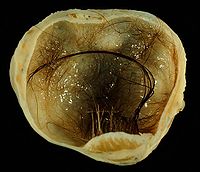
Photo from wikipedia
Nonaccidental head injuries are significant causes of morbidity and mortality among young children. Despite broad agreement among medical experts, controversies remain over diagnostic criteria, including from autopsies, because of opinions… Click to show full abstract
Nonaccidental head injuries are significant causes of morbidity and mortality among young children. Despite broad agreement among medical experts, controversies remain over diagnostic criteria, including from autopsies, because of opinions expressed by a small group of expert witnesses who testify for defendants in suspected child homicide cases. We reviewed 249 autopsies in children 2 years old and younger from the files of our Medical Examiner office in the University of Missouri School of Medicine done between January 1, 2008 and December, 31, 2016. Because of gradually instituted mandatory examination of spinal cords and retinas, we had 127 autopsies with brain examinations by a neuropathologist plus retinal examinations of which 67 also had spinal cord examinations. Results were correlated with clinical records, police and EMS reports, and imaging. We found that subdural hematomas, cerebral edema, and retinal hemorrhages were mostly limited to autopsy findings in children who suffered from fatal head trauma, whether accidental (3 cases) or inflicted (14); they were not encountered in cases of homicide by other mechanisms or from natural diseases including infections, brain tumors, SIDS/SUID, or SUDC. Two cases with no other evidence of head trauma had focal retinal hemorrhages. We advocate for examination of retinas and spinal cords in all autopsies of children in this age group.
Journal Title: Journal of neuropathology and experimental neurology
Year Published: 2022
Link to full text (if available)
Share on Social Media: Sign Up to like & get
recommendations!